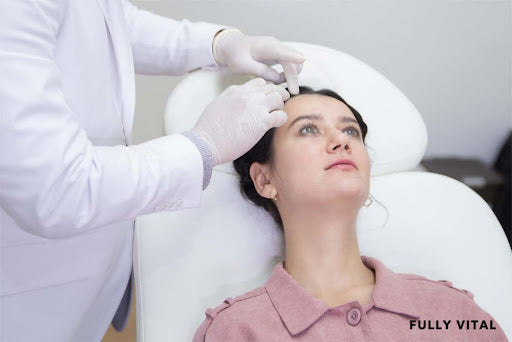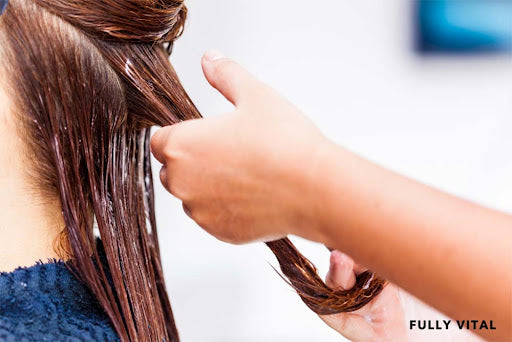
Scalp Reduction: A Comprehensive Guide for Women's Hair Growth
As women, we all desire luscious, full, and healthy hair.
However, sometimes hair loss and thinning become an unwelcome companion in our lives.
Fortunately, there are numerous techniques and solutions available to stimulate hair growth, one of which is scalp reduction.
In this article, I'll answer all your burning questions about scalp reduction and its importance in achieving the hair of your dreams.

I LOVE MY HAIR NOW
FullyVital hair serum and hair vitamins made tremendous improvements in my hair. I truly love my hair now.
Dorit S.,
What Is Scalp Reduction?
Scalp reduction is a surgical procedure that can help individuals struggling with hair loss regain a fuller head of hair.
It involves removing a portion of the bald scalp and stretching the adjacent hair-bearing skin to cover the area.
This results in a smaller bald area and a more even distribution of hair.

Why Is Scalp Reduction Important?
For women of all hair types looking to stimulate hair growth, scalp reduction offers a viable solution.
It provides a way to address large bald patches or areas of thinning hair, improving the overall appearance and boosting confidence.
How Does Scalp Reduction Work?
During the scalp reduction procedure, a surgeon strategically removes sections of bald scalp.
The surrounding hair-bearing skin is then stretched and stitched together to cover the bald area.
This technique helps to reduce the noticeable baldness and optimize the hair density in the treated region.
What Are The Benefits Of Scalp Reduction?
Scalp reduction offers several benefits for individuals seeking hair growth stimulation:
Enhanced Hair Density
By reducing the bald area, scalp reduction improves the density of existing hair, creating a fuller and thicker appearance.
Improved Hairline
Scalp reduction can help individuals achieve a more natural-looking hairline by filling in receding or thinning areas.
Boosted Confidence
Restoring a fuller head of hair can significantly boost self-esteem and confidence, allowing individuals to feel more comfortable and satisfied with their appearance.
Are There Any Downsides To Scalp Reduction?
Like any surgical procedure, scalp reduction also has potential downsides to consider. It's important to be informed before deciding if it's the right choice for you:
- Scarring: Scalp reduction surgery may result in visible scars, especially if a large area is treated. However, skilled surgeons employ techniques to minimize scarring and make it less noticeable.
- Potential Side Effects: While uncommon, some individuals may experience temporary complications such as swelling, bruising, or infection following the procedure. These can typically be managed with proper care and medical attention.
What Are The Alternatives To Scalp Reduction?
While scalp reduction can be an effective option for hair growth stimulation, there are alternative treatments available to consider:
Topical Medications
There are various over-the-counter and prescription topical treatments, such as minoxidil and finasteride, that can help stimulate hair growth and slow down hair loss.
Hair Transplantation
Hair transplantation involves harvesting hair follicles from one part of the scalp, usually the back or sides, and transplanting them to the desired bald or thinning areas.
This technique provides a more natural and permanent solution.1
Laser Therapy
Low-level laser therapy devices can be used at home or in a clinical setting to stimulate hair regrowth by increasing blood circulation and promoting healthier follicles.2
What Is The Process Of Scalp Reduction?
When considering scalp reduction as a solution for hair loss, it's crucial to understand how the process works. Here's a breakdown of the key steps involved:
- Consultation: Your hair loss concerns will be thoroughly assessed during a consultation with a qualified surgeon. They will evaluate your hair loss pattern and the condition of your scalp to determine if scalp reduction is a suitable option for you.
- Surgical Procedure: The scalp reduction surgery is typically performed under local anesthesia. The surgeon will remove the bald skin in the targeted area while preserving the hair-bearing scalp around it. The remaining scalp will be stretched and sutured, reducing the size of the bald spot.
- Recovery: Following the procedure, proper care and adherence to post-operative instructions are essential for a smooth recovery process. This typically includes dressing changes and gentle scalp care to promote healing.
What Are The Various Components Of Scalp Reduction?
Scalp reduction involves various components that contribute to its effectiveness. Let's break down these elements:
- Bald Area Removal: The surgeon carefully removes the bald skin on the scalp, eliminating the areas of hair loss.
- Remaining Scalp Stretching: After removing the bald skin, the surgeon stretches the remaining scalp to cover the excised area. This stretching technique aims to reduce the size of the bald spot and maximize hair coverage.
- Suture Techniques: Skillful suturing is crucial in scalp reduction surgery. Surgeons use different suturing techniques to achieve an optimal outcome, including trichophytic closure and various pattern designs.
What Are Some Various Techniques In Scalp Reduction?
Scalp reduction techniques may vary depending on individual circumstances and the surgeon's expertise.
Below, we will explore some commonly used techniques:
Precautionary Trichophytic Closure
This technique minimizes scarring by carefully aligning the hair follicles on the opposing scalp edges during closure.
It helps ensure a more natural hairline appearance post-surgery.3
Z-Plasty
This technique involves creating a "Z" pattern incision, allowing the surgeon to redistribute the tension across a larger area of the scalp.
It aids in achieving better symmetry and minimizing tension on the sutures.
Tissue Expansion
In some cases, tissue expansion may be used prior to scalp reduction surgery.
This technique involves inserting an inflatable balloon-like device under the scalp, gradually expanding it to create excess scalp tissue for better coverage.
What Are Some Key Considerations And Steps Involved In The Scalp Reduction Procedure?
Now that we have discussed the technique, process, and components of scalp reduction, let's take a more in-depth look at the procedure:
- The surgical procedure usually takes place under local anesthesia, meaning you will be awake but may not feel any pain or discomfort during the surgery.
- The size of the balding area and the desired outcome will determine the extent of the scalp reduction procedure.
- Follow-up appointments will be necessary to monitor the healing process and ensure the best possible results.
- It is essential to have an open and honest discussion with your surgeon about any concerns or questions you may have regarding scalp reduction.
What Are Some Important Factors To Keep In Mind Regarding The Outcomes Of Scalp Reduction?
Scalp reduction surgery has helped many women achieve significant improvements in hair growth and overall confidence.
However, it is essential to understand the realistic outcomes and manage expectations. Here are some key points to consider:
- Improved Hair Density: Scalp reduction can enhance hair density by redistributing the existing hair follicles. This can result in thicker-looking hair and increased coverage.
- Natural Appearance: When performed by a skilled surgeon, scalp reduction can provide a more natural hairline and a balanced distribution of hair across the scalp.
- Individual Variations: Each person's results may vary depending on factors such as hair texture, quality, and the extent of hair loss. It is essential to have realistic expectations and discuss desired outcomes with your surgeon.
Experience The Power Of Fully Vital: Unlock Your Hair's Full Potential!Experience the transformation your locks deserve with Fully Vital's science-backed hair growth products. Discover the benefits:
Choose Fully Vital for a healthier relationship with your locks. |
Final Thoughts On Scalp Reduction
Scalp reduction serves as an important solution for women looking to stimulate hair growth and enhance their overall hair density.
Through the removal of bald skin and strategic stretching of the remaining hair-bearing scalp, scalp reduction offers substantial benefits, including enhanced aesthetics, increased hair density, and a boost in self-confidence.
While considering scalp reduction, it is essential to evaluate the potential risks and weigh them against the potential benefits with a qualified healthcare professional.
At Fully Vital, we understand the importance of maintaining a healthy relationship with your locks.
That's why we offer a variety of hair growth products designed to stop the aging of your hair.
Our products aim to nourish and revitalize your hair, supporting its growth and promoting a fuller, healthier appearance.
Embrace the opportunity to take control of your hair growth journey and achieve the luscious locks you desire.
Remember, each individual's experience with hair loss may differ, and it is crucial to consult with a healthcare professional to determine the most suitable approach for your unique needs.
With the right guidance and the right hair growth products, you can embark on a journey to regain your confidence and enjoy vibrant, healthy-looking hair.
Frequently Asked Questions On Scalp Reduction
Can women undergo scalp reduction?
Yes, women can undergo scalp reduction surgery to address their hair loss concerns.
The suitability for scalp reduction will depend on individual hair loss patterns, hair density, and overall health.
Who are ideal candidates for scalp reduction?
Ideal candidates for scalp reduction are individuals who:
- Have extensive hair loss or a large balding area.
- Have good hair density in the remaining hair-bearing areas.
- Have realistic expectations regarding the outcomes of the procedure.
- Are in good overall health and do not have any medical conditions that may interfere with the surgery or recovery process.
Does scalp reduction help with hair loss?
Yes, scalp reduction can significantly help address hair loss concerns.
By reducing the size of the balding area and redistributing the existing hair follicles, scalp reduction aims to improve hair density and create a more natural-looking hairline.
What is the primary purpose of scalp reduction?
The primary purpose of scalp reduction is to decrease the size of the balding area on the scalp and improve hair coverage.
This can result in a more balanced and aesthetically pleasing hairline, boosting self-confidence and overall satisfaction with one's appearance.
Is scalp reduction a safe procedure?
When performed by a qualified and experienced surgeon, scalp reduction is generally considered safe.
However, as with any surgical procedure, there are potential risks and complications to be aware of.
What is the recovery process like after scalp reduction?
Scalp reduction recovery involves mild discomfort, swelling, and limited activity. Follow surgeon's advice, take prescribed pain meds, protect from sun, and attend follow-up appointments for suture removal and healing monitoring.
Do the results of a scalp reduction last?
The results of scalp reduction are considered long-term.
However, it is important to note that further hair loss may occur in other areas of the scalp as it is a progressive condition.
Can scalp reduction surgery leave scars?
Scalp reduction surgery will involve an incision and sutures, which may result in scarring.
However, skilled surgeons employ various techniques to minimize scarring and ensure a more natural-looking hairline.
How many sessions does it take to see visible results?
Scalp reduction is typically a one-time surgical procedure.
Visible results will depend on individual healing and hair growth rates.
Can scalp reduction be combined with other hair restoration procedures?
Yes, scalp reduction can be combined with other hair restoration procedures for comprehensive results.
Some individuals may benefit from additional treatments like hair transplantation or low-level laser therapy to further enhance hair growth and thickness.
Sources:
- Zito, P. M., & Raggio, B. S. (2021). Hair Transplantation. PubMed; StatPearls Publishing. https://www.ncbi.nlm.nih.gov/books/NBK547740/
- Avci, P., Gupta, G. K., Clark, J., Wikonkal, N., & Hamblin, M. R. (2013). Low-level laser (light) therapy (LLLT) for treatment of hair loss. Lasers in Surgery and Medicine, 46(2), 144–151. https://doi.org/10.1002/lsm.22170
- Oh, S. J. (2019). Closure of a full-thickness scalp burn that occurred during hair coloring using a simple skin-stretching method: A case report and review of the literature. Archives of Plastic Surgery, 46(02), 167–170. https://doi.org/10.5999/aps.2018.00871







